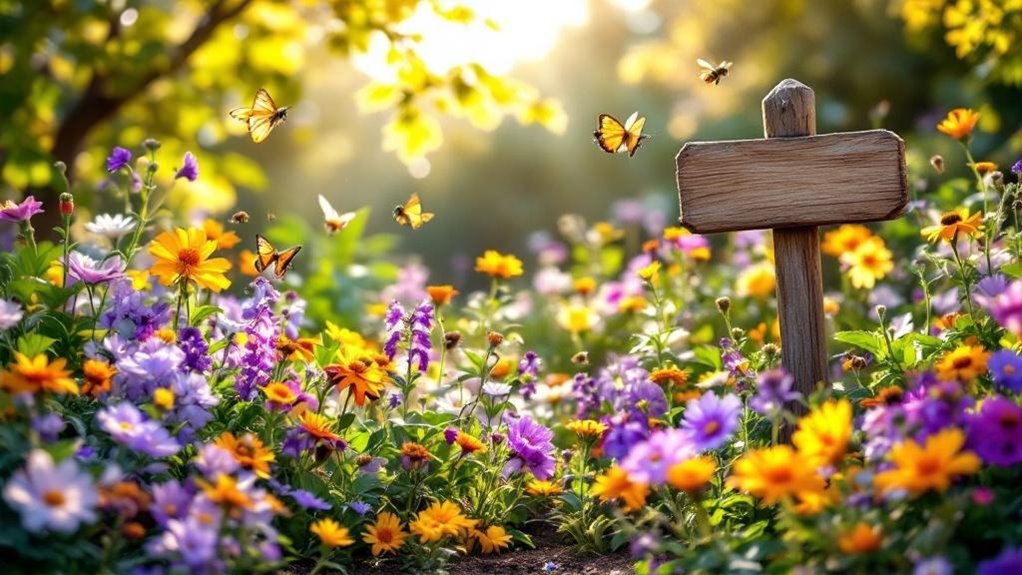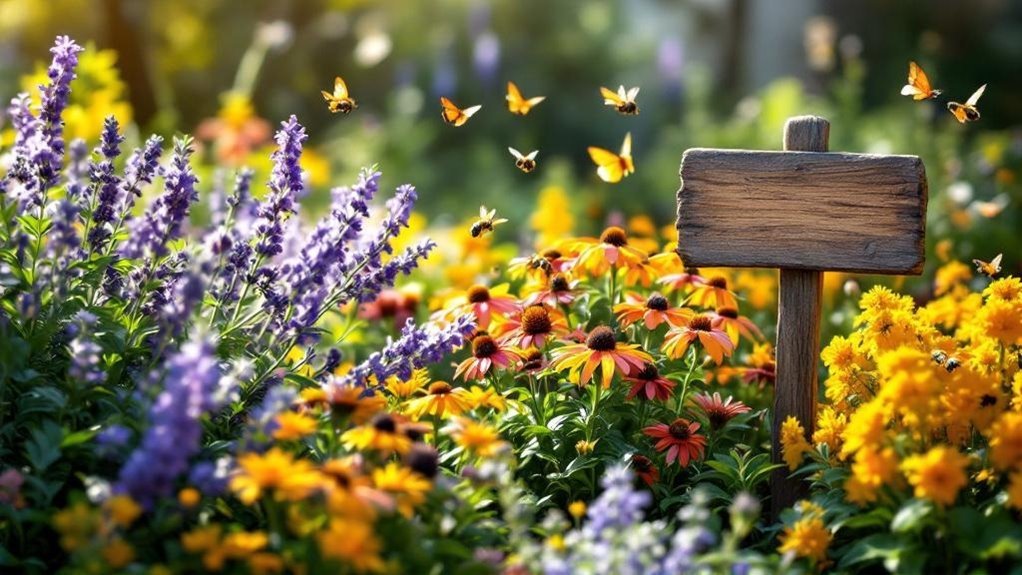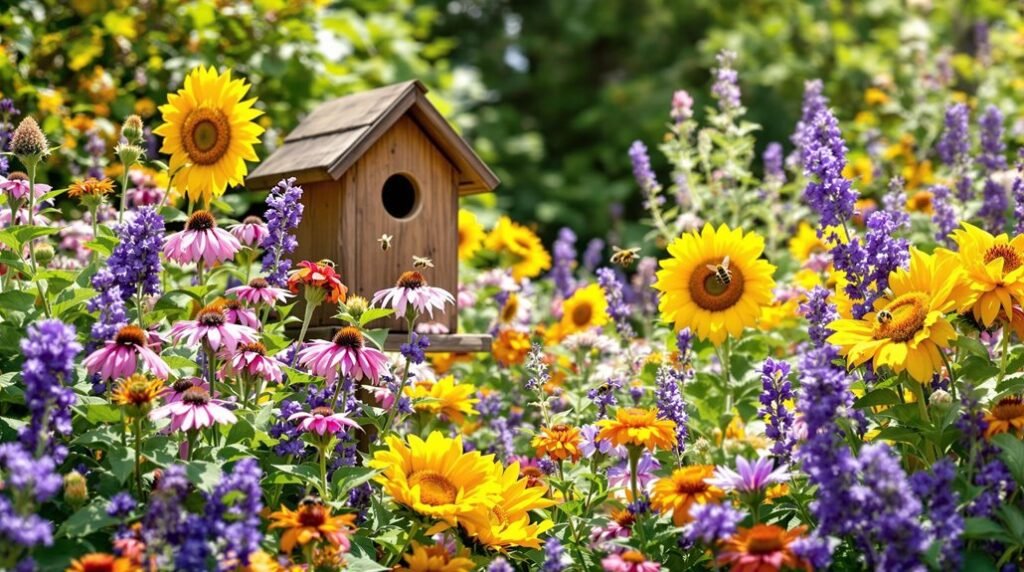Creating a garden that quietly invites nature’s helpers takes more than just planting flowers. You’ll want to carefully select a spot with plenty of sun and access to water, then prepare the soil to support a variety of native plants. Knowing which species to choose and how to arrange them can make all the difference in attracting pollinators throughout the seasons. There’s more to contemplate if you want a truly thriving habitat.
Selecting the Ideal Garden Location
When selecting the ideal garden location, you should pick a spot that gets at least six to eight hours of direct sunlight daily, since most pollinator plants need bright conditions to grow well and produce nectar.
Choose a location near a water source like a rain barrel or garden hose to make watering your pollinator gardens easier. Conduct a shadow study to guarantee nearby trees or structures won’t cast shade during peak sunlight hours.
Avoid areas with heavy foot traffic to give pollinators a safe, undisturbed space to forage. Also, select a spot sheltered from strong winds, which can stress plants and discourage pollinators.
Preparing the Planting Area
Before planting, clear your chosen spot by removing existing vegetation using sheet mulching, which layers cardboard, compost, and leaf litter to enrich the soil without disturbing its structure.
Preparing the planting area well sets the foundation for healthy native plants and vibrant pollinators. Level the soil and ascertain good drainage by removing grass and debris.
Remember to space your plants about one per square foot to give each room to flourish. Choose a sunny location with at least six to eight hours of sunlight daily.
- Feel the excitement of creating a buzzing, colorful haven
- Watch your garden transform into a lively pollinator paradise
- Enjoy the satisfaction of nurturing native plants sustainably
- Anticipate the joy of supporting essential pollinator species
Choosing Native Pollinator Plants

Once you’ve prepared your planting area, the next step is selecting native pollinator plants that will thrive in your garden’s conditions.
Native plants are the best plants for creating a pollinator friendly space because they’re adapted to your local climate and provide the specific nectar and pollen native pollinators need.
To support pollinators year-round, aim for a diverse mix of native flowering plants blooming from early spring to late fall.
Avoid modern hybrids, as they often lack sufficient pollen and nectar.
Consider implementing the 3 x 3 x 3 system by planting three native species for each season, totaling nine species.
For example, including milkweed is crucial for Monarch butterflies.
With the right native plants, you’ll create a vibrant, pollinator friendly garden that sustains local wildlife effectively.
Designing Your Garden Layout
Although selecting the right plants is crucial, designing your garden layout thoughtfully guarantees they thrive and stay accessible.
Thoughtful garden design ensures plants flourish while remaining accessible and inviting.
Start by creating in-ground beds about 3 feet wide to avoid soil compaction and allow diverse planting. Arrange native plants and pollinator plants by height—tallest at the back or center, shorter at edges—to guarantee everyone gets sunlight. Incorporate pathways for easy movement and maintenance. Use stakes and string to mark planting areas while keeping local climate and soil in mind.
Consider adding structural elements like trellises or bird baths to attract more pollinators and add charm.
Your garden becomes a vibrant sanctuary when you:
- Craft inviting, accessible beds
- Plan for sunlight and space
- Provide safe pathways
- Enhance habitat with thoughtful structures
Utilizing the 3 X 3 X 3 Planting System

To maximize the impact of your thoughtfully designed garden layout, try the 3 x 3 x 3 planting system. Select three native plant species for each season—spring, summer, and late summer/fall—totaling nine species. Plant three individuals of each, resulting in 27 plants that provide continuous food and habitat for native pollinators. Arrange them by height, flower color, and bloom time in an 8×4-foot area to create a vibrant, staggered display of flowering plants. This setup guarantees your garden supports pollinators throughout the growing season.
| Season | Plant Selection |
|---|---|
| Spring | 3 native plants |
| Summer | 3 native plants |
| Late Summer/Fall | 3 native plants |
Creating Diverse Habitat Features
When you create diverse habitat features in your garden, you provide essential resources that support a wide range of pollinators year-round. Incorporate native plants and host plants that bloom in different seasons, ensuring continuous nourishment.
Leave patches of bare soil for ground-nesting bees and add untreated wood blocks with holes to shelter cavity-nesting bees. Maintain leaf litter and dead plant stems to offer safe hiding spots for caterpillars and beneficial insects.
Consider adding structural elements like trellises or brush piles to invite butterflies and hummingbirds.
- Feel the joy as native wildflowers burst into color, feeding busy pollinators.
- Watch caterpillars crawl safely beneath the leaf litter you preserved.
- Hear buzzing bees use your wood blocks as cozy homes.
- Delight in butterflies dancing around your garden’s vibrant host plants.
Providing Water Sources for Pollinators
Adding water sources complements the diverse habitats you’ve created by meeting another crucial need for pollinators. To support butterflies and bees, provide shallow water sources like bird baths or dishes filled with pebbles, ensuring they can hydrate safely without drowning.
Place these water sources in sunny spots near flowering plants to attract more pollinators seeking food and water. Change the water regularly to keep it fresh and inviting. You can also add small fountains or dripping water features to create movement, which draws pollinators in.
Incorporate various textures such as stones or twigs to offer landing spots, making it easier for pollinators to drink. By thoughtfully providing water sources, you’ll help sustain butterflies and bees, enhancing your pollinator-friendly garden’s success.
Avoiding Harmful Chemicals and Pesticides
Although pesticides might seem like a quick fix for garden pests, they can seriously harm pollinators by disrupting their nervous systems and reducing their ability to reproduce and forage.
To protect pollinator health, embrace organic gardening methods that avoid harmful chemicals. Use natural pest deterrents like neem oil or insecticidal soap, and adopt integrated pest management (IPM) strategies to apply treatments only when necessary.
Avoid herbicides and fungicides that can also damage pollinators by trying mulching or hand-pulling weeds instead.
Remember, your choices can make a difference:
- Save buzzing bees from toxic exposure
- Preserve butterfly populations for future generations
- Nurture a thriving, vibrant garden ecosystem
- Inspire your community to choose pesticide-free gardening
Protect pollinators by ditching pesticides and choosing organic gardening practices.
Incorporating Nesting and Shelter Areas
To support pollinators beyond providing flowers, you should create nesting and shelter areas that meet their specific habitat needs. Provide untreated wood blocks with drilled holes as secure nesting sites for cavity-nesting bees. Leave bare soil patches for ground-nesting bees to burrow and lay eggs safely. Additionally, construct bug hotels using logs and straw to offer shelter for diverse insects. Leaving dead stems and leaf litter also gives butterflies overwintering space.
| Pollinator Type | Nesting & Shelter Strategy |
|---|---|
| Cavity-nesting bees | Drilled wood blocks for nesting sites |
| Ground-nesting bees | Bare soil patches to lay eggs |
| Butterflies & insects | Bug hotels, dead stems, and leaf litter shelter |
Maintaining and Caring for Your Pollinator Garden
Creating nesting and shelter areas helps pollinators find safe places to live, but maintaining your garden keeps those habitats thriving.
To maintain a healthy garden ecosystem, you need to plant and grow with care, ensuring your pollinator garden stays vibrant and supportive.
Here’s how you can keep your garden flourishing:
- Water regularly, especially during dry spells, adjusting based on rainfall.
- Leave dead flowers and leaf litter to provide habitat for beneficial insects.
- Avoid pesticides; choose organic methods to protect pollinator species.
- Thin overcrowded seedlings and prune dead plant material while preserving stems for overwintering pollinators.
Frequently Asked Questions
How Do You Start a Pollinator Garden?
You start by picking a sunny spot with nearby water, then clear and prep the soil. Choose native plants blooming throughout seasons, group them, avoid pesticides, and add nesting spots to attract and support pollinators effectively.
What Plants Are Best for a Pollinator Garden?
You’ll want native plants like milkweed, coneflowers, and black-eyed Susans. Include sunflowers for bees, butterfly bush for butterflies, and red flowers to attract hummingbirds. Avoid hybrids—they often lack pollen and nectar.
What Qualifies as a Pollinator Garden?
Imagine a buzzing symphony where flowers feed and homes bloom; you create a pollinator garden by planting native blooms, avoiding pesticides, and offering shelter—inviting bees, butterflies, and hummingbirds to thrive and dance all season long.
What Time of Year Should I Plant My Pollinator Garden?
You should plant your pollinator garden in spring after the last frost to help plants establish. Fall’s great for native perennials, too. Just check your local frost dates and stagger blooms for continuous pollinator support.
Final Thoughts
Creating a pollinator-friendly garden not only supports essential wildlife but also boosts your plants’ health and productivity. Did you know that over 75% of the world’s flowering plants rely on pollinators to reproduce? By choosing native plants, providing water, and avoiding pesticides, you’re making a big difference in their survival. With just a little care, your garden can become a thriving haven for bees, butterflies, and other pollinators all season long.
